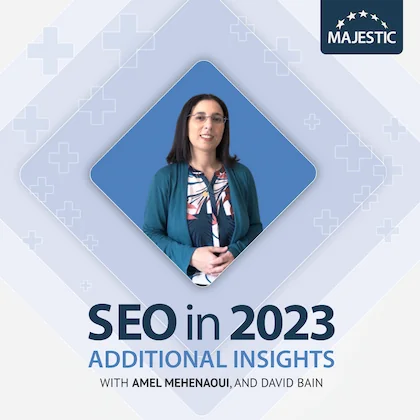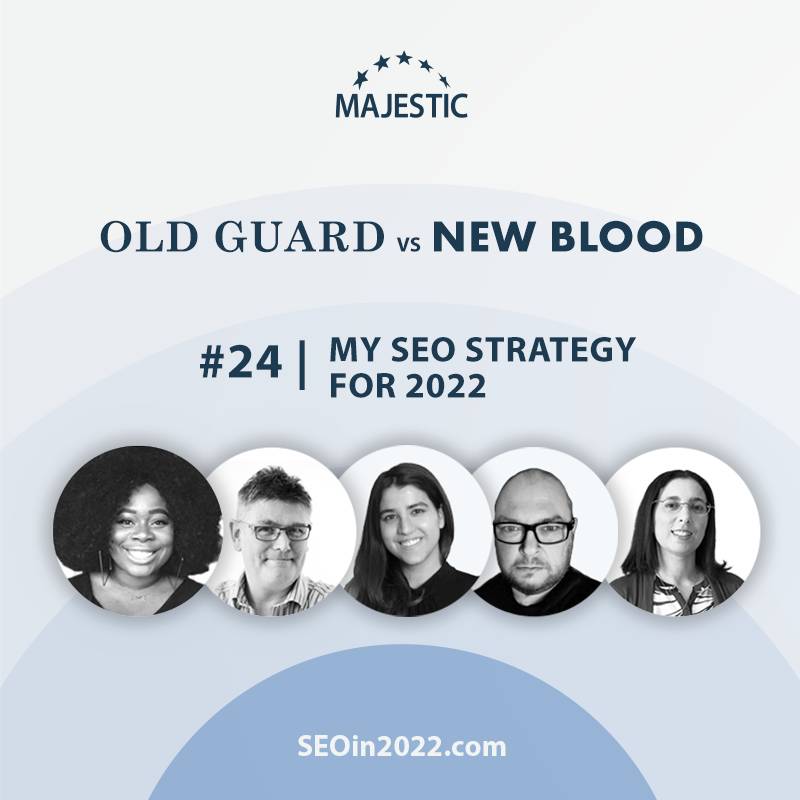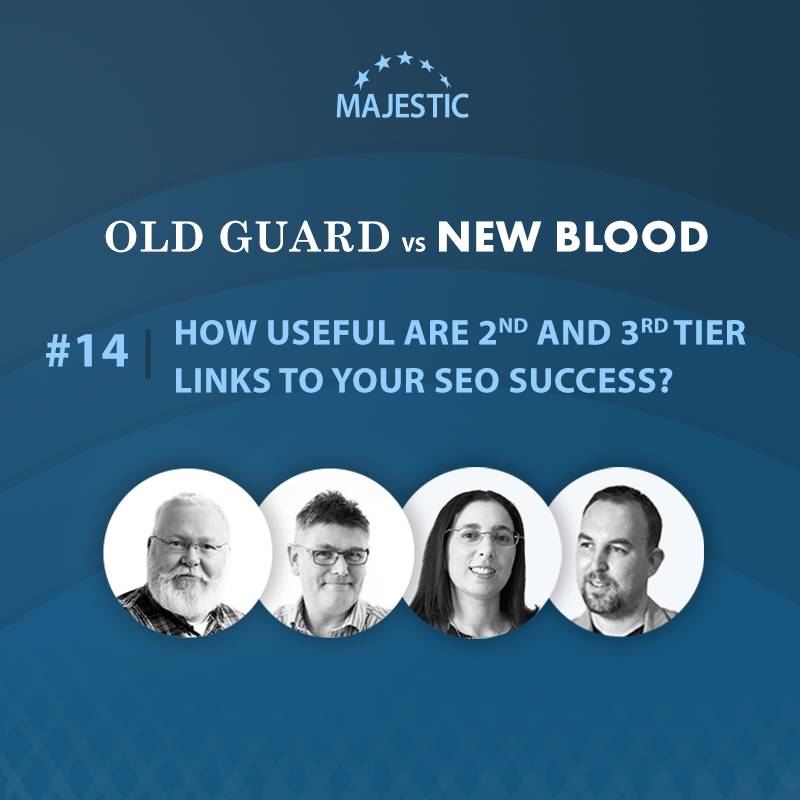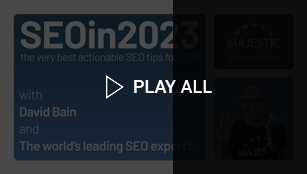-
Site Explorer
- Majestic
- Summary
- Ref Domains
- Backlinks
 New
New Lost
Lost- Context
- Anchor Text
- Pages
- Topics
- Link Graph
- Related Sites
- Advanced Tools
- Author ExplorerBeta
- Summary
- Similar Profiles
- Profile Backlinks
- Attributions
- Compare
-
Link Tools
- My Majestic
- Recent Activity
- Reports
- Campaigns
- Verified Domains
- OpenApps
- API Keys
- Keywords
- Keyword Generator
- Keyword Checker
- Search Explorer
- Link Tools
- Bulk Backlinks
- Neighbourhood Checker
- Submit URLs
- Experimental
- Index Merger
- Link Profile Fight
- Mutual Links
- Solo Links
- PDF Report
- Typo Domain
- Free SEO Tools
- Support
Optimize Your Product Images for Google's AR Feature
Amel Mehenaoui
Amel Mehenaoui explains that Google aims to immerse users in the digital world with a dynamic and interactive search experience by introducing augmented reality, which presents untapped potential for SEOs.

Amel Mehenaoui says “My additional insight is really, specifically for ecommerce stores to optimize their product images to show up on the Google's AR feature on search results.”
Right. Okay. Yeah. And I guess for SEOs that haven't looked into it that much, what is really Google's AR feature and where can users find it?
“So the, the AR feature is really about augmented reality and Google was testing a lot in the last few years. And since 2019 they added it to the search engine result pages, mostly when you are on your mobile. And the way it works really is once you have an image, a product image on your website, and it's optimized for the augmented reality, and you have a 3D model, you know, of your image, then if you do, you add actually the right tags, and you optimize it the right way, you can actually be featured on the Google AR. And the way it works, really, it's when you're on your mobile and you see the icon, there's an icon that shows that it's an AR, it looks like a cube, a 3D cube, and then when you click on it, you can project the image of the product in your real life environment, which is amazing. So, if you are, for example, an ecommerce furniture store, and you're selling office desks, for example, and you're you have a 3D model of your desk and your office desk, then you add, as I said, a bit of optimization using different tools, using schema markups, and optimizing the meta data. And if your product is showing up on the search results, and someone looks at your office desk, and then they click on that, to view it with AR, they will be able to projected it, for example, in their office, and they can see how it looks like. So it's really a way that Google really wants to actually make user immersed in the digital world in a way, and make it make search more dynamic and interactive. So that's why they added this amazing feature. And so far, not a lot of ecommerce websites are taking advantage of it. So, there is a lot of potential for ecommerce with augmented reality.”
Okay, okay, so lots to dive into there. Firstly, what kind of reach is available through augmented reality listings like that? For instance, how did Google make the decision for your listing to actually appear as a keyword related, I presume? And does it give those listings rate or prominence when they're available for certain searches?
“Yes, yes, definitely. So really, as I said, Google's main goal and then for the last decade is really to make sure that the users are using Google and staying longer on Google search results. And so this using, you know, 3D model of your products, it will give you the opportunity to show up in the image carousel when you when somebody is doing a search about your product. So, as I said, as I gave the example of an office desk, so someone is looking for an office desk, and your image is actually optimized for AR. And you have, as I said, the 3D model of the product, you will be prominently showing up on the AR feature. And it's actually an additional opportunity for Google to make people stay on Google because from the search results, you will be projecting, you know the product in your real environment by staying on the search results. So by clicking on the image, this, as I said, the icon, the 3D cube icon, and projecting itself, or if it's a 3D image, you can actually see the 3D image. So, it's going to be more and more prominent. And obviously, if you don't have it, then you will not show up. But if you already have the meta tags in place, and adding specific elements in your HTML, then you will have more chances that Google will actually feature you in the AR feature.”
So maybe they're trying to build their own 3D version of Pinterest where people can actually gather up collections of potential furniture to have in their home in the future. And it's all very well and good for Google to keep people on their SERP using their service longer. But do you have any data that indicates that people looking at these kinds of results are more likely to make a purchase?
“That's a good point. I don't have the stats, but I know that big brands are currently using the augmented reality. And it really helps with conversion, because one thing it actually helps with is really making sure that the users when they project the image in their environment, they're going to be happy with how it's going to look like. So you will have less returns, because usually what happens is, if you buy a product, you don't know how it's going to look like in your room or in your office or you know, in your space, then you bring it home, you put it and then you're like, oh, no, it doesn't work. So you return it, but having 3D model using the AR, this actually helps you retain your customer. It helps really increase the conversion, because customer can see how the product will be in live space. And at the same time, because if let's say they're trying to match their decor, to whatever furniture they're buying, then they will have less returns. So that's really important. Big brands are using, as I said, the AR, for example, IKEA, they actually use it, they have their products and 3D model images of their products. And this can help, as I said, like help the customer see and envision how it looks like in their environment, which is, which is really important. So it's already being implemented by some big brands. Obviously, I think the challenge is for small businesses, small ecommerce websites that don't maybe have the team in place to help them make that happen. So right now, the best examples of brands who are using the 3D image, beside IKEA, you have Home Depot also, that are using it. And you can actually see Home Depot products on Google search, using what Google calls “view in 3D”. So that's the feature, as I told you, this small icon feature, and you have Wayfair, who also are using it, they have a feature. If you go to Wayfair, they call the “view in the room”, and the customer can see the furniture, whatever they're trying to purchase. They use it in their in their space. So yes, as I said, the concern is mostly for small businesses, small ecommerce who don't know how to do that. So, they're missing out.”
How do SEOs actually get their images crawled and indexed by Google? Is it as simple as actually incorporating these images on a web page and using certain markup code to indicate that these images occur? Is it perhaps an RSS feed, similar to product feeds or something else?
“So let's say in general, if you want to optimize, if you want your images to show up on the search results, obviously, you have to optimize the images for SEO. So this is like not even talking about AR at this point, we're talking just regular images of your product. Okay. And then we will add the AR 3D model component to it. So first of all, right now, as an ecommerce website, you have, obviously to optimize your images. And in SEO, what we usually use and to help the bots and the search engine understand that this is an image, and to explain what the image is about, we use metadata. So simply put, we tell Google, we use schema markup, and we just describe the image to Google and tell Google, this is an image, this is the name of the image, we give a description and tell Google what's on that image, and we use the alt tag. So Alt tag, it helps with accessibility. So for people who can’t see so they hear what what's on the screen. So if you use alt tag on the image, it will tell them what the image is about. That's, you know, something that we use, and also, what's very important, is the file name, the way you name the image file is important, you need, again, to tell Google what's this image is about. So, you would use the keywords that describe that image and you will name the file of that image with that keyword.
Now, let's say if we take it like in a basic way, and try to explain it to an ecommerce manager, someone who doesn't know about SEO, the way you think about it is by naming your images with the description and the exact words that describe what's on that image, what you're doing is you're actually helping the algorithm when they are indexing these images, it's easy for them to retrieve the image that's relevant to whatever people are searching on the search engine. So let's go back to my office desk. If you name your image of his desk, let's say “L shaped office desk”, because it's an L shape desk, and you add all the metadata information, what you're doing, you're simplifying it for the bots, the way that they can retrieve this image. If someone goes to Google, and they search for L shaped office desk, the retrieval will be faster, and it will be better because you are using the correct words. But if you name your image image321, x, z, it means nothing, you know, and if you're not using metadata to describe what's on that image, first of all, you're not helping, the accessibility part. So people who can't see when they listen to the text, then they can’t know what's that image, alright, so we're not helping there. But at the same time, your image doesn't have the correct words in the file name, there is no metadata to explain what the image is about, there is no alt tag to, again, give a good, relevant explanation of what the image is. So, retrieving that in the index, well, compare that like, unknown image, 123, X, Z, whatever, and L shaped office desk, well it will be easier to retrieve this one and return it in the search results. So, it's very important to really take care of optimizing the metadata, the file name, and the alt tag. That's the first part of it.”
I was just going to say, in terms of file type, does the file type have to be AR, specifically? AR is a file type as well, isn't it?
“That's a good question. Yes, I'm going to get to the AR. So I was really explaining the images in general. All right, now we'll talk about AR and the 3D modeling. Yes, the format of the image is important. So, once you have your really nice high resolution image of your product, you need to turn it in a 3D model. And the format for that should be and this is actually recommended by Google, it's GLB. So GLB is the format that you would use. And there's a lot of tools that you can create a 3D model with. So you have some open source tools that you can use to create the 3D model. I have no relationship with these tools, I'm just sharing them with you. You have Blender, which is an open source, easy to use, and you have SketchUp that you can use to create a 3D model of your product image. These are open source. If you go with commercial, there's commercial tools, I'm sure you heard about Autodesk Maya, they specialize in this thing. So you make your image 3D image, and then you use the format GLB. And when you do that, Google recommends to use a script. And the script is what we call model viewer. And this model viewer, when you take your URL of that image with the format GLB, and you add that model viewer script, you're telling Google that this is a 3D image, and that's kind of the format on a web page for 3D images to be read. It's going to be the GLB.”
You've shared what SEOs should be doing in 2023. So now let's talk about what SEOs shouldn't be doing. So, what's something that's seductive in terms of time, but ultimately counterproductive? What's something that SEOs shouldn't be doing in 2023?
“Okay, that's a great question. Well, I'm sure you heard by now about different AI tools, like AI content tools that are supposed to help us out. We obviously, as an SEO, we need to publish a lot of content. And currently with all the different AI tools they're supposed to help us but we're spending a lot of time creating this content with AI tools, but the content is not really optimized for human beings and for the SEO at the same time. So, the tone is a little bit robotic, and it may not offer as much value added as it should be when it's done by human beings. So, we should not be spending time, you know, trying to create those AI content in a way that it's not optimized for human beings. Because at the end of the day, yes, we want our content to rank, but we want people to read the content, because we want people to reshare the content, link to this content, and so on. So, I would say yes, AI content tools are made for us to be more productive, but let's be careful about the way we're actually creating content using these tools to make it more productive and not counterproductive in a way.”
Amel Mehenaoui is a digital marketing consultant, and you can find her over at LATmultilingual.com.
Also with Amel Mehenaoui
Choose Your Own Learning Style
 Video
Video
If you like to get up-close with your favourite SEO experts, these one-to-one interviews might just be for you.
Watch all of our episodes, FREE, on our dedicated SEO in 2023: Additional Insights playlist.
 Podcast
Podcast
Maybe you are more of a listener than a watcher, or prefer to learn while you commute.
SEO in 2023: Additional Insights is available now via all the usual podcast platforms
 SEO in 2023
SEO in 2023
Catch up on SEO tips from 101 SEO experts in the original SEO in 2023 series
Available as a video series, podcast, and a book.
Could we improve this page for you? Please tell us







